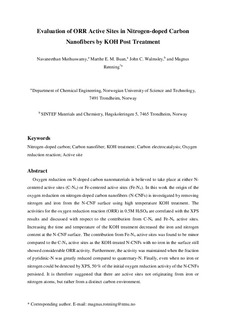| dc.contributor.author | Muthuswamy, Navaneethan | |
| dc.contributor.author | Buan, Marthe Emelie Melandsø | |
| dc.contributor.author | Walmsley, John | |
| dc.contributor.author | Rønning, Magnus | |
| dc.date.accessioned | 2017-12-05T09:57:36Z | |
| dc.date.available | 2017-12-05T09:57:36Z | |
| dc.date.created | 2017-12-04T09:06:31Z | |
| dc.date.issued | 2018 | |
| dc.identifier.citation | Catalysis Today. 2018, 301 11-16. | nb_NO |
| dc.identifier.issn | 0920-5861 | |
| dc.identifier.uri | http://hdl.handle.net/11250/2469217 | |
| dc.description.abstract | Oxygen reduction on N-doped carbon nanomaterials is believed to take place at either N-centered active sites (C-Nx) or Fe-centered active sites (Fe-Nx). In this work the origin of the oxygen reduction on nitrogen-doped carbon nanofibers (N-CNFs) is investigated by removing nitrogen and iron from the N-CNF surface using high temperature KOH treatment. The activities for the oxygen reduction reaction (ORR) in 0.5 M H2SO4 are correlated with the XPS results and discussed with respect to the contribution from C-Nx and Fe-Nx active sites. Increasing the time and temperature of the KOH treatment decreased the iron and nitrogen content at the N-CNF surface. The contribution from Fe-Nx active sites was found to be minor compared to the C-Nx active sites as the KOH-treated N-CNFs with no iron in the surface still showed considerable ORR activity. Furthermore, the activity was maintained when the fraction of pyridinic-N was greatly reduced compared to quaternary-N. Finally, even when no iron or nitrogen could be detected by XPS, 50% of the initial oxygen reduction activity of the N-CNFs persisted. It is therefore suggested that there are active sites not originating from iron or nitrogen atoms, but rather from a distinct carbon environment. | nb_NO |
| dc.language.iso | eng | nb_NO |
| dc.publisher | Elsevier | nb_NO |
| dc.rights | Attribution-NonCommercial-NoDerivatives 4.0 Internasjonal | * |
| dc.rights.uri | http://creativecommons.org/licenses/by-nc-nd/4.0/deed.no | * |
| dc.title | Evaluation of ORR active sites in nitrogen-doped carbon nanofibers by KOH post treatment | nb_NO |
| dc.type | Journal article | nb_NO |
| dc.type | Peer reviewed | nb_NO |
| dc.description.version | acceptedVersion | nb_NO |
| dc.source.pagenumber | 11-16 | nb_NO |
| dc.source.volume | 301 | nb_NO |
| dc.source.journal | Catalysis Today | nb_NO |
| dc.identifier.doi | 10.1016/j.cattod.2017.03.045 | |
| dc.identifier.cristin | 1522225 | |
| dc.relation.project | EC/FP7/280658 | nb_NO |
| dc.relation.project | Norges forskningsråd: 197405 | nb_NO |
| dc.description.localcode | © 2017. This is the authors’ accepted and refereed manuscript to the article. LOCKED until 8.4.2019 due to copyright restrictions. This manuscript version is made available under the CC-BY-NC-ND 4.0 license http://creativecommons.org/licenses/by-nc-nd/4.0/ | nb_NO |
| cristin.unitcode | 194,66,30,0 | |
| cristin.unitcode | 194,66,20,0 | |
| cristin.unitname | Institutt for kjemisk prosessteknologi | |
| cristin.unitname | Institutt for fysikk | |
| cristin.ispublished | true | |
| cristin.fulltext | postprint | |
| cristin.qualitycode | 2 | |

